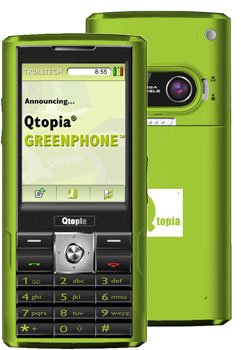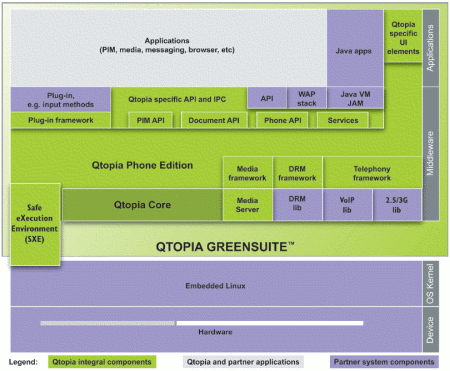Trolltech rolls “complete” Linux smartphone stack
Nov 28, 2006 — by LinuxDevices Staff — from the LinuxDevices Archive — 4 viewsTrolltech, perhaps the most successful Linux smartphone software provider, is readying a more comprehensive stack aimed at simplifying Linux-based phone development. The company's “Greensuite,” due in Q2, will offer a menu of pre-integrated browsers, Java virtual machines, messaging clients, and other software, along with complete source code and branding flexibility, the company says.
digg this story |
Within the mobile phone software market, Linux has long been lauded for its tremendous flexibility, while being criticized for being less complete than off-the-shelf software platforms like Symbian and Windows Mobile. Trolltech hopes Greensuite will help close the gap, offering license consolidation and technical integration higher into the application software stack, while keeping all of Linux's customizability and re-brandability.
 Trolltech Co-CEO Haavard Nord says Trolltech decided to address integration issues after creating the Greenphone (pictured at right) — its first hardware product, a reference platform for device and application developers using the company's Qtopia Phone Edition, (QPE) Linux smartphone software stack. “We're not really a hardware company,” Nord said. “But, we put ourselves in the shoes of our customers for a few months, and faced the nitty gritty details of software integration. We learned that integrating 10 percent of the software can take 90 percent of the time, so we decided to solve that problem.”
Trolltech Co-CEO Haavard Nord says Trolltech decided to address integration issues after creating the Greenphone (pictured at right) — its first hardware product, a reference platform for device and application developers using the company's Qtopia Phone Edition, (QPE) Linux smartphone software stack. “We're not really a hardware company,” Nord said. “But, we put ourselves in the shoes of our customers for a few months, and faced the nitty gritty details of software integration. We learned that integrating 10 percent of the software can take 90 percent of the time, so we decided to solve that problem.”
Nord adds, “It's a natural evolution for us. We started at the bottom with Qt/Embedded, then built the Qtopia platform, then QPE, and then the Greenphone, to provide an open hardware platform. And now, the Greensuite.”
Greensuite's basic OS/middleware layer
The initial Greensuite will target smartphones, followed by other Greensuites for less expensive hardware, such as feature phones and VoIP handsets, Nord said. He explained, “Greensuite is initially a smartphone OS for dual-processor architectures. As mobile phone hardware advances, [Greensuite] will go more into the feature-phone category.”
The initial Greensuite will use Trolltech's recently shipped Greenphone as a hardware reference platform. However, the stack will support any hardware platform to which Linux has been ported, Nord said.
Greensuite will be based on a forthcoming 4.2 release of QPE, the company's mature graphics framework and middleware stack for Linux-based mobile phones. Like QPE itself, the Greensuite will not include a kernel, but rather a full graphics and middleware layer that runs on top of 2.4- or 2.6-based Linux kernels.

Greenphone function block diagram
(Click to enlarge)
Intriguingly, QPE 4.2 appears to include a “Safe Execution Environment” (SXE) aimed at letting users download and install native Linux applications over the air, without requiring carriers to laboriously test and certify them first.
Nord sounded reluctant to say too much in advance of QPE 4.2's availability, but did comment, “SXE takes advantages of mechanisms built into Linux, where you can confine [resources used by] processes, and their access to the filesystem, and to network sockets. We built a protocol around that, so when you install a new application, you give it a set of privileges, and if it violates them — say it tries to read a file or send an SMS message — the application will be killed and the user will get some message.”
Nord continued, “SXE is similar to Java sandboxing, but done at the native application level. Operators are terrified of handsets that can be hacked, that could compromise their networks. That's the reason why proprietary closed handsets have been living for such a long time.”
Third party components
Along with QPE 4.2, Greensuite will be available pre-integrated with a variety of software components, from specific vendors to be announced later. Nord said, “The browser, JVM, and messaging are the top priorities for our customers.”
Other Greenphone components will include:
- WAP and HTML browser
- Messaging solution
- Multimedia package including video and audio recording
- DRM
- 3D graphics
- 2.5G and 3G Telephony enabled, including Video Telephony
- VoIP support
- Java MIDP, CLDC, and various JSRs
- Document viewing and editing, VPN client, synchronization tools
Nord said that Trolltech hopes to offer greater choice and flexibility than other “fully integrated” stack providers. Consistent with this strategy, today's Greensuite announcement was accompanied by a set of partner endorsements from:
- Timo Bruns, executive VP of business development at browser vendor Opera Software
- Blane Rockafellow, founder of telephony stack provider TapRoot
- Magnus Hedencrona, CEO of Mimer, a Swedish vendor of multi-user SQL RDBMSes (relational database management systems)
- Sulaiman Thompson, CTO of DRM framework provider Beep Science
- Fabrizio Capobianco, CEO of SyncML/push-email stack vendor Funambol
- Milos Djokovic, CEO of instant messaging client stack specialist Zi Corp.
- Jeff Ayars, VP product engineering at streaming media software specialist RealNetworks
- Jim Ready, CTO of Linux kernel porting specialist MontaVista
- Goran Svennarp, senior marketing director of Swedish phone application vendor Teleca
Nord continued, “In terms of getting components in place, we are pretty much there today. But one area that is big, and needs more work, is operator adaptations. We're still catching up, there.”
“We like to emphasize that we're offering a menu — the customer can pick and choose. With Access, the customer would be encouraged to get the Access JVM and NetFront browser, so it's more of a prix fixe menu,” Nord added.
Recently, Trolltech has touted support for OpenWave's Mercury browser, while Access also offers its NetFront for Qtopia. “We hope Access will continue to support Qtopia, as they have in the past,” Nord said.
Ayars (of RealNetworks) noted that “By pre-integrating open technologies like the Helix DNA Client multi-media framework with Qtopia Phone Edition, handset companies can lower their Linux phone development costs.”
Catering to operators, ODMs, OEMs
Many large network operators, especially in the U.S. and in Europe, define extensive interface and software component requirements. Fulfilling such operator requirements can place a significant burden on phone designers hoping their products will be distributed by such carriers. Nord said that Trolltech hopes to ease that burden by addressing specific operator requirements in Greensuite.
Nord noted that the relative lack of operator requirements in Asian markets has helped Linux succeed there, early on. He said, “China Mobile will take any phone that customers want, and sell it with just a logo.” In contrast, in Europe and the U.S., operators want “a deeper integration, and more customization.”
“European and U.S. vendors are also just more conservative about adopting new handsets,” Nord continued. “Here in Silicon Valley, I see handsets advertised by carriers as 'new' that I saw two years ago, in Asia. But, I believe Motorola has announced that it will now begin to roll out its Linux phones in the U.S. and in Europe.”
Nord said that in addition to use by ODMs (original design manufacturers) contracted to build phones for specific carrier networks, Greensuite could be used by OEMs (original equipment manufacturers) building “unlocked” phones for use on any network of a given technology, such as GSM/GPRS — similar to the OpenMoko-based Neo1973 from FIC. “What we're hearing from OEMs and ODMs is that they would like to spend more time tuning for operators. It is their choice whether to ship a phone that's locked or open. We want to give them the tools to build open phones, but it's not up to us to decide,” he added.
Thus, major ODMs such as HTC, a leading vendor of Windows Mobile-based phones, could theoretically use Greensuite to roll out Linux-based versions of their hardware designs.
Nord noted, “The advantage of Windows Mobile and Symbian up to this point has been integration, that helps designers bring products to market in a short time. But the downside is that their hands are tied, and they can't do much about the user interface. The big difference is that we ship all the source code.”
“We also let OEMs/ODMs change any aspect of the interface. We don't try to control the brand. We would like to establish brand awareness of the Qtopia stack among developers creating applications for phones, but whether end users know us, I don't care. What I care about is to make the developer's job as easy as possible,” added Nord.
In a statement, Quocirca analyst Rob Bamforth commented that “Any platform needs a rich ecosystem as well as solid underlying technology. Simplifying the development cycle through targeted, product-ready software offerings is key to the continued success of Linux for mobile devices.”
Eirik Chambe-Eng, Trolltech's other co-CEO, stated, “Qtopia Greensuite represents the strong ecosystem of partner technology that exists and supports the Qtopia Phone Edition platform for mobile phones. With our strong history of Linux, our ability to provide a proven platform with support, training, and consultancy services, and now a pre-integrated suite of technology, handset manufacturers/designers, telecom operators, and application developers can now focus on their devices' innovative features.”
Availability
Trolltech will demonstrate the Greensuite at the ITU World Telecom 2006 conference in Hong Kong, Dec. 4-8, and at the 3GSM show in Barcelona, Feb. 12-15. Greensuite is expected to reach general availability in Q2, 2007.
This article was originally published on LinuxDevices.com and has been donated to the open source community by QuinStreet Inc. Please visit LinuxToday.com for up-to-date news and articles about Linux and open source.